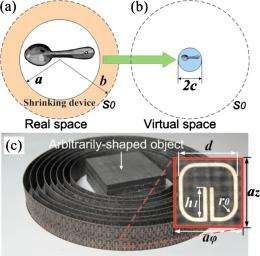May 31, 2011 feature
Shrinking device makes objects appear smaller than they are

(PhysOrg.com) -- By controlling how light bends around an object, researchers have built a shrinking device that makes objects appear smaller than they actually are. Although the original object does not actually shrink, the illusion of the smaller object is convincing enough to confuse viewers since the real size of the object cannot be perceived.
The team of engineers, led by Wei Xiang Jiang and Tie Jun Cui from Southeast University in Nanjing, China, has published their study on their shrinking device in a recent issue of Applied Physics Letters.
“The shrinking device can shrink the size of an object virtually, so we named it a ‘shrinking device,’” Cui told PhysOrg.com. “Such a device works at microwave frequencies and will confuse the radar or other electromagnetic detection equipment to make wrong decisions. Hence it may have potential applications in the military.”
The researchers built the shrinking device out of metamaterials, which are best known for their role in invisibility cloaks. When used in the field of transformation optics, metamaterials can bend light and control its path in desired ways.
Here, the researchers used metamaterials to build eight concentric rings that are each 12 mm high. They then placed an arbitrary object, such as a spoon, in the center of the rings. When light waves propagate through the shrinking device, the wave fronts begin to bend and their wavelengths get compressed. When the light reaches the inner circular region, the wavelengths become decompressed. To an observer on the outside of the shrinking device, the manipulated light creates the illusion of a smaller object with the same shape as the real object.
“The device is designed by using transformation optics, which make the objects in the real space and virtual space look like the same,” said Cui. “In our design, the real object is a large one and the virtual object is a small one. With the help of shrinking device, the scattering field of the large object becomes the same as that of the small one.”
As the researchers explained, the shrinking device works somewhat like the beginnings of an invisible cloak since both devices involve shrinking the radius of the inner circular region. For the shrinking device, the radius of this space is always positive. But as the radius approaches zero, the shrinking device becomes a perfect invisibility cloak.
“An object can be made to appear arbitrarily small as desired,” said Cui.
The researchers demonstrated the shrinking performance both numerically and experimentally, and found that the experimental results agreed very well with the simulations. The results showed that the device had an overall “good shrinking performance,” with the illusion looking like an exact smaller version of the original object.
As the researchers noted, because some objects’ proportions depend on their sizes, the shrinking device could even generate virtual objects of small sizes that do not exist in nature.
In addition, the methods used here to design the shrinking device could be extended to design and realize other illusion devices, such as devices that can change some of the other parameters of an object.
More information: Wei Xiang Jiang, et al. “Shrinking an arbitrary object as one desires using metamaterials.” Applied Physics Letters 98, 204101 (2011). DOI:10.1063/1.3590203
Copyright 2011 PhysOrg.com.
All rights reserved. This material may not be published, broadcast, rewritten or redistributed in whole or part without the express written permission of PhysOrg.com.



















